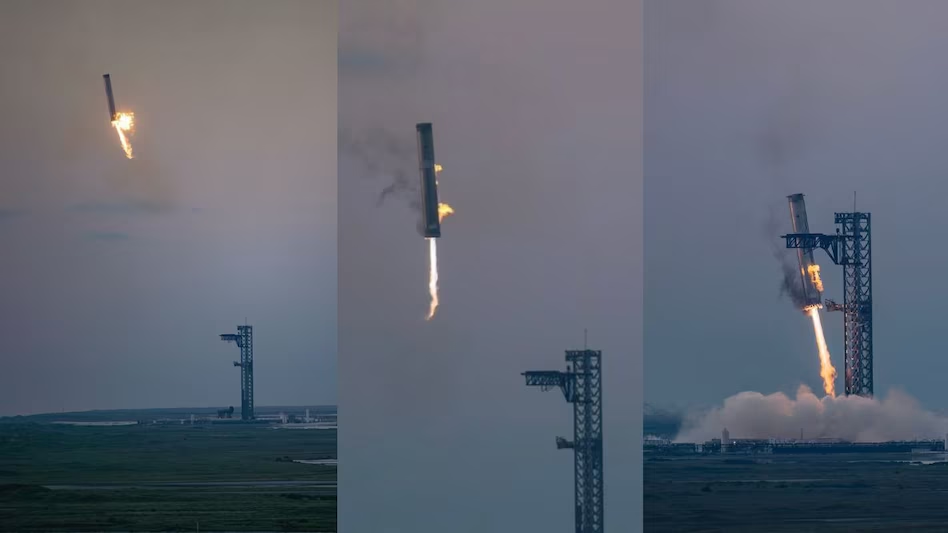Mechazilla: Revolutionizing Rocket Recovery for SpaceX’s Starship
SpaceX has recently achieved a significant milestone in space exploration by landing its Starship rocket using an innovative structure called “Mechazilla.” This tall, advanced structure, equipped with massive mechanical arms, has transformed the methods of rocket recovery, marking a major advancement in reusable rocket technology. As the aerospace industry continues to push the boundaries of what’s possible in space travel, Mechazilla stands out as a game-changing innovation that could redefine the future of rocket launches.

What is Mechazilla?
Mechazilla is the nickname given to the impressive 400-foot-tall rocket-catching structure located at SpaceX’s Starbase in South Texas. This engineering marvel features two enormous mechanical arms, often referred to as “chopsticks,” designed specifically to catch the Super Heavy booster as it returns to Earth. This novel method of rocket recovery is significantly more efficient and reusable compared to traditional landing techniques, such as those employed by SpaceX’s Falcon 9 rocket, which typically lands on a drone ship or solid ground.
Elon Musk, the visionary CEO of SpaceX, has provided insights into Mechazilla’s purpose and design. In a previous video, he explained, “This is a custom-built tower with arms that are designed to catch the largest flying and heaviest flying object ever made and pluck it outta the air. It’ll weigh about 250 tons. We’ll make that lighter over time.” His description emphasizes the engineering challenges involved in catching an object weighing hundreds of tons plummeting toward Earth at more than half the speed of sound.
How Mechazilla Works
The operation of Mechazilla involves several critical phases during the launch and landing process:
- Launch and Ascent: The SpaceX Starship rocket, equipped with its Super Heavy booster, launches from the ground, ascending into the atmosphere with immense power.
- Booster Separation: Once the rocket reaches a designated altitude, the Super Heavy booster separates from the upper stage, allowing the Starship to continue its mission while the booster begins its descent back to Earth.
- Controlled Descent: During its descent, the booster utilizes precision thrusters to control its trajectory and speed, ensuring that it remains on course for landing.
- Catching the Booster: As the booster approaches the landing site, Mechazilla’s giant arms move into position. The booster hovers momentarily before the arms catch it, ensuring a safe and controlled landing. This method eliminates the need for the booster to land on a platform or drone ship, reducing the risk of damage during landing.
Importance of Mechazilla for SpaceX
The advanced method of landing facilitated by Mechazilla has several advantages for SpaceX. Primarily, it significantly reduces wear and tear on the booster. Traditional landing techniques often involve considerable stress on the rocket, which can lead to extensive maintenance and refurbishment between flights. By catching the booster midair, SpaceX can quickly refurbish and reuse it, thereby significantly decreasing turnaround time and lowering launch costs.
Furthermore, this innovative recovery method enhances the sustainability of space missions. As the world increasingly prioritizes environmental responsibility, SpaceX’s reusable technology aligns with the goal of reducing waste in space exploration. By reusing rockets rather than discarding them after each flight, the aerospace industry can minimize its environmental footprint and increase the feasibility of frequent space missions.
Future Implications of Mechazilla
The success of Mechazilla has far-reaching implications for the future of space travel. As SpaceX continues to refine this technology, it could lead to more frequent and cost-effective space missions, making space exploration more accessible for a broader audience. This capability could be particularly transformative for scientific research, satellite deployment, and even potential manned missions to Mars and beyond.
Moreover, as other companies observe SpaceX’s advancements with Mechazilla, we may see a new wave of innovation in rocket recovery systems across the industry. Competitors could develop their own versions of advanced recovery structures, leading to increased collaboration and competition that ultimately benefits space exploration.
The engineering achievements represented by Mechazilla underscore the significant strides made in aerospace engineering. Innovations like this serve as a reminder of the power of human ingenuity and creativity, as well as the collaborative efforts that drive the industry forward. With every successful mission, SpaceX paves the way for the next generation of space exploration.
Conclusion
In summary, Mechazilla is not just a remarkable engineering feat; it represents a paradigm shift in how rockets are recovered and reused in space missions. By introducing a method that dramatically reduces wear and tear on the Super Heavy booster and shortens turnaround times, SpaceX is setting a new standard for the aerospace industry. As we look to the future, the potential for more accessible and sustainable space exploration is becoming increasingly tangible. Mechazilla is poised to be a key player in this transformative journey, showcasing how innovative technology can reshape the landscape of space travel for generations to come.
For more: News




